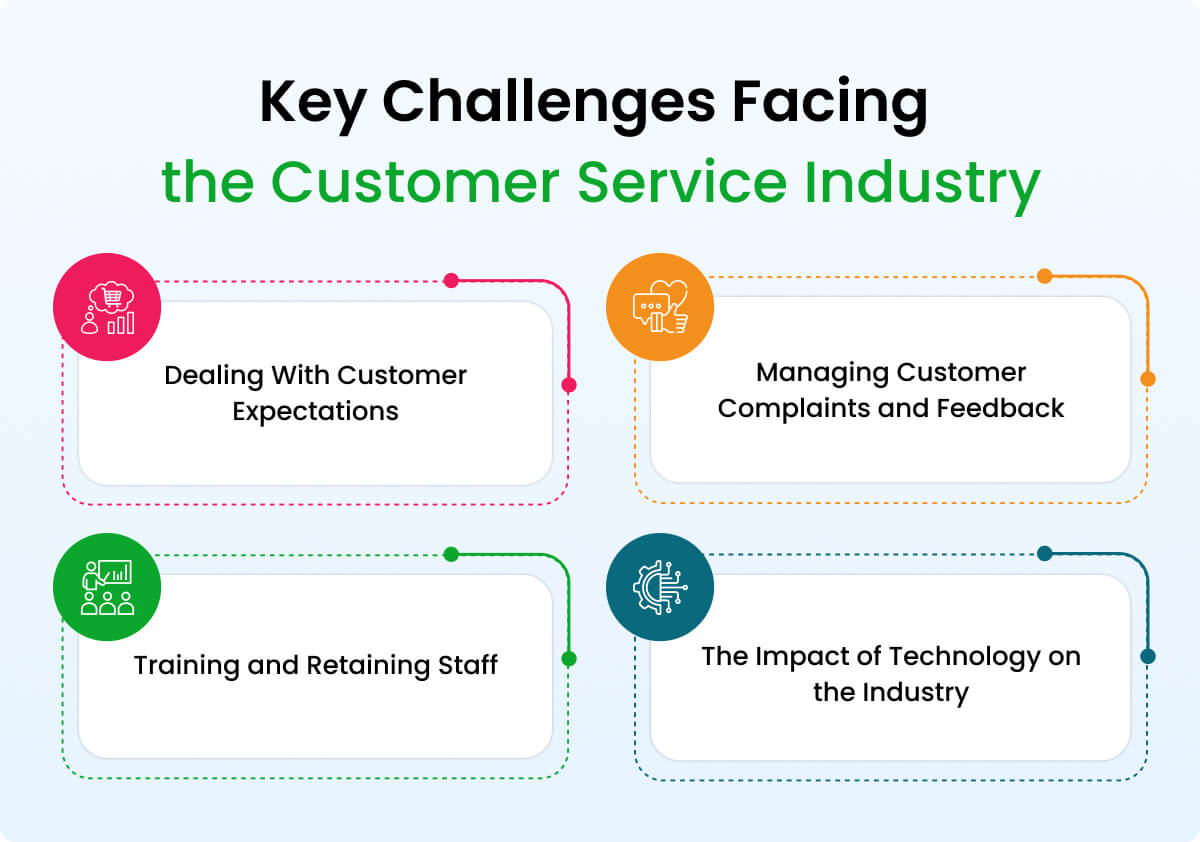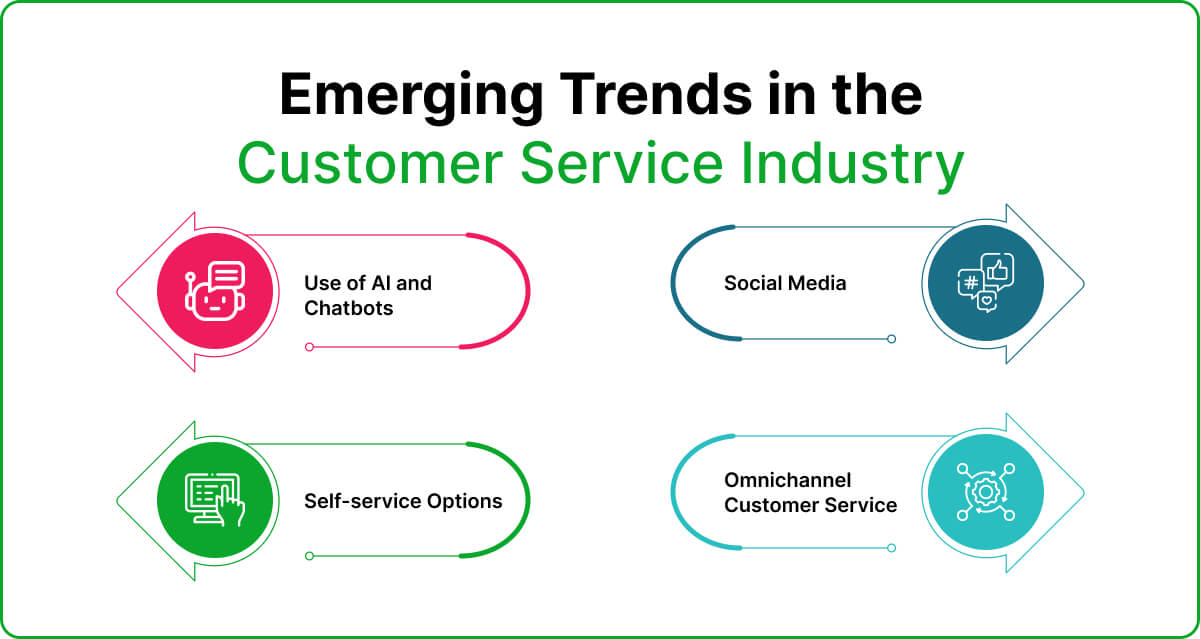 Customer Service
Customer Service

20 April, 2023

No matter what size business you are a fledgling venture or an established enterprise– you have surely noticed the breakneck pace at which the industry has evolved over the past decades. It has been transitioning from traditional methods such as phone and email support to more modern channels like social media, chatbots, and self-service portals.
With the increasing use of technology and changing consumer preferences, companies are adopting new strategies to provide faster, more personalized, and more convenient customer service experiences. Today, the customer service industry is focused on leveraging data analytics, AI (Artificial Intelligence), and automation tools to improve customer interactions and enhance overall satisfaction.
Now you are about to know how staying current with the latest trends and innovations can leverage your customer support operations.
Contents
When you look for the customer service industry definition, you will find a circle of businesses that provide support and assistance to customers before, during, and after they purchase a product or service. This can involve a wide range of activities, such as answering questions, resolving issues, processing orders, and providing technical support.
One of the prominent customer service industry examples is Amazon. They provide a variety of customer service options, including phone, email, and chat support, as well as self-service options like their online help center and community forums.
When you have a clear perception of the customer service industry meaning, you have already known what to do right now. And that is to keep pace with the industry.
Hence, you need to constantly adapt and evolve to meet the changing needs and expectations of your customers. It means investing in employee training and development to ensure that your customer service team has the skills and knowledge needed to provide high-quality support.
Simultaneously, you should aim to actively solicit feedback from customers and use that feedback to continuously improve and refine your support processes.
When you are off to industry, it means you are looking for your customers, the latest process to do business. Knowing the industry means knowing your customers, and this concept emphasizes the importance of understanding the broader trends and patterns in the customer service industry in order to better serve your own customers. Let’s get to know how knowing the industry can impact your business positively.
As the customer service industry evolves, so do customer expectations. By staying up-to-date with industry trends and best practices, businesses can ensure that they are meeting and exceeding their customers’ expectations for support and assistance.
The industry generates a vast amount of data on customer interactions and feedback. By leveraging this data, businesses can identify common pain points and issues that their customers are experiencing, and work to address them proactively. As a whole, it will let you be good at the customer service industry standards which help you take the very first step before anyone.
As the customer service industry continues to evolve, new technologies and tools are emerging that can improve efficiency and streamline operations. For example, AI-powered chatbots can handle routine customer inquiries and free up support staff to focus on more complex issues. By adopting these technologies, businesses can reduce costs and improve response times, leading to higher customer satisfaction.
Keeping pace with the customer service industry can also provide a competitive advantage for businesses. By adopting new technologies and tools before their competitors, businesses can differentiate themselves in the marketplace and attract new customers.
Along with the positive effects you will also come across some significant challenges while surfing the industry. These challenges require you to be proactive in your approach to customer service, leveraging new technologies and support systems. Meanwhile, you also need to prioritize employee development and create a positive and supportive work environment. By addressing these issues head-on, you can position yourself for long-term success and growth in an increasingly competitive marketplace.

One of the biggest challenges facing the customer service industry is meeting the ever-increasing expectations of customers. With the rise of digital technologies, customers have come to expect quick and efficient service across multiple channels. Meeting these expectations can be challenging for businesses, particularly those with limited resources or outdated support systems. To address this challenge, businesses must invest in modern support technologies such as AI-powered chatbots, self-service portals, and mobile apps, while also providing ongoing training and support to their support staff.
Another major challenge facing the customer service industry is managing customer complaints and feedback. Customers are increasingly vocal in their feedback, whether positive or negative, and businesses must be prepared to respond quickly and appropriately to these messages. This requires a comprehensive system for tracking and responding to customer inquiries, as well as ongoing monitoring of customer sentiment across multiple channels. In addition, businesses must take a proactive approach to address customer complaints and feedback, working to resolve issues quickly and effectively to avoid a negative impact on their brand reputation.
Effective customer service requires a skilled and motivated team of support staff. However, with high turnover rates and a shortage of skilled professionals, training and retaining staff can be a significant challenge for businesses. To address this challenge, businesses must provide ongoing training and development opportunities for their support staff, as well as create a positive and supportive work environment that encourages employee engagement and loyalty. This may include offering competitive salaries and benefits, promoting work-life balance, and fostering a culture of continuous improvement and professional development.
Finally, the impact of technology is a major challenge facing the customer service industry. While new technologies such as AI, chatbots, and self-service portals can improve efficiency and streamline operations, they also require significant investment and ongoing maintenance. Additionally, these technologies can sometimes lead to a disconnect between businesses and their customers, as customers may prefer human interactions over automated customer support. To address this challenge, businesses must strike a balance between adopting new technologies and maintaining a human touch in their customer interactions. This may include offering hybrid support models that combine automated and human support, as well as ongoing monitoring of customer feedback to identify areas where technology can be improved or expanded.
The customer service industry trends are shaping the way businesses interact with their customers. In order to stay competitive, businesses must keep up with these advancements and adapt their customer service strategies accordingly. In this context, this section will discuss some of the key emerging trends that you need to pursue for being competitive.

These technologies offer businesses the ability to provide quick and efficient support to their customers, while also reducing costs and increasing efficiency. AI-powered chatbots can handle routine inquiries and provide personalized support to customers 24/7, freeing up human support staff when they give more time to solve more complex issues. Moreover, AI and chatbots can be integrated with other customer service tools, such as mobile apps, to provide a seamless and intuitive customer experience.
Social media has emerged as a powerful tool for customer service, providing businesses with a direct line of communication with their customers. Customers increasingly expect businesses to be responsive on social media, with many using platforms like Twitter and Facebook to ask questions, make complaints, and leave feedback.
To meet these expectations, businesses must have a dedicated social media support team that can respond quickly and effectively to customer inquiries and complaints. They must also monitor social media channels regularly to stay on top of customer sentiment and identify emerging trends and issues.
Self-service portals are becoming increasingly popular among customers who prefer to solve problems on their own. These portals offer customers a range of tools and resources, such as FAQ (Frequently Asked Questions) sections, and troubleshooting guides, that allow them to find answers to common questions and issues.
And most importantly, it needs no human touch. Self-service portals can help businesses reduce support costs and improve customer satisfaction, but they must be well-designed and intuitive to use in order to be effective.
Finally, omnichannel customer service is a cutting-edge way to interact with customers across multiple channels, including in-person, social media, email, chat, and phone. Businesses must have a seamless and integrated support system that allows them to provide consistent support across all channels. It also requires personalizing the support experience simultaneously to meet individual customer needs.
A comprehensive customer data management system here can track customer interactions and preferences across all channels. Not to mention a skilled and motivated support team, they can provide high-quality support regardless of the channel used by the customer.
The potentialities in the customer service industry are vast and varied, with endless opportunities for businesses to improve their customer service strategies. It differentiates businesses from their competitors and builds a strong and loyal customer base in an increasingly competitive marketplace.
You must prioritize employee development and training to ensure that your support teams are equipped to handle the changing needs of customers. The future is surely full of opportunities for those who are willing to embrace change and innovation. So, if you wish to stay ahead of the curve to create long-term success with your product/service, take the big step right now.